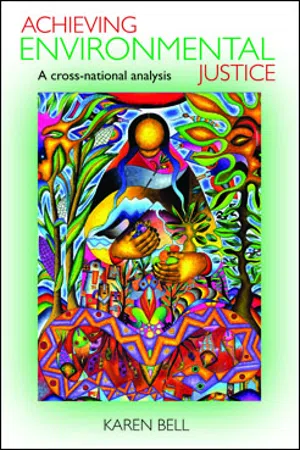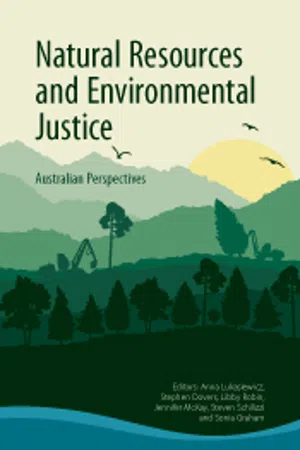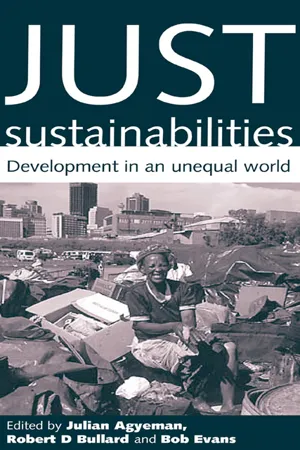Geography
Environmental Injustice
Environmental injustice refers to the unequal distribution of environmental burdens and benefits among different social groups. This can include the disproportionate exposure to pollution and environmental hazards experienced by marginalized communities, as well as the lack of access to environmental resources and amenities. Environmental injustice is often rooted in systemic inequalities and can have significant social, economic, and health impacts.
Written by Perlego with AI-assistance
Related key terms
9 Key excerpts on "Environmental Injustice"
- eBook - ePub
- Diane Sicotte(Author)
- 2016(Publication Date)
- Rutgers University Press(Publisher)
5Within the context of the law, Kristin Shrader-Frechette has identified several different aspects of Environmental Injustice, including distributive injustice (the unequal distributions of hazards); participative injustice (unequal opportunity to participate in decisions regarding possible or known hazards); procedural injustice; lack of compensation for health or economic damage resulting from environmental hazards; and inequities to future generations.6In the context of governance, making less frequent inspections of hazardous facilities and taking a longer time to clean up Superfund sites in disadvantaged or minority communities have been identified as forms of Environmental Injustice.7 Others have identified Environmental Injustice with unequal vulnerability to harm in the wake of disasters.8 Finally, issues including harm from global climate change, unequal access to healthy drinking water, workers’ exposure to toxic hazards on the job, the contamination of communities and drinking water from mining and gas and oil extraction, the export of hazardous waste and industries to poorer countries, and many others have come under the rubric of environmental justice.9 Given this dizzying array of issues, places, claims of injustice, affected populations, and possible causes, it is not surprising that researchers have defined environmental justice and injustice in many different ways.10In the United States, a large proportion of research on Environmental Injustice has focused on the unequal and unjust distribution of environmental hazards (distributional injustice).11 Even this aspect of Environmental Injustice is far from simple, because it is closely related to participatory injustice. Participatory injustice refers to inequalities of power and knowledge that plague legal and political processes of deliberation about where noxious facilities should be located, the thoroughness and timeliness of hazardous site cleanups, and so on. In light of these inequalities, decisions resulting in unequal distributions can be said to result from the lack of recognition of social differences between groups.12 This lack of recognition then causes less valued groups to experience disrespect and exclusion from political participation, rendering them more vulnerable to unequal distributions of hazards and risks.13 - eBook - ePub
Achieving Environmental Justice
A Cross-National Analysis
- Bell, Karen(Authors)
- 2014(Publication Date)
- Policy Press(Publisher)
TWOThe concept and measurement of environmental justice
Individually and collectively, people around the world have opposed Environmental Injustice for hundreds of years.1 However, most commentators agree that the conceptualisation and use of the term ‘environmental justice’ first emerged in the 1980s, out of resistance to the siting of toxic facilities in black and other minority ethnic communities in the United States. A defining moment was the publication of research that reported that hazardous installations, such as toxic waste dumps, were often located in areas with higher percentages of ‘people of color’ (UCC, 1987). This study was followed by further investigations that confirmed that poor and minority ethnic communities in the US were disproportionately exposed to environmental hazards (for example, Bryant and Mohai, 1992; Adeola, 1994; Cutter, 1995) and received unequal protection under environmental law (for example, Kratch, 1995). These findings led to accusations of ‘environmental racism’ and the growth of an environmental justice movement made up of tenants’ associations, civil rights groups, agricultural workers, religious groups, non-governmental organisations (NGOs), academics, trades unions and other civil society organisations. However, unlike previous environmental groups in the US, which had focused on the protection of wilderness and endangered species, this movement focused on the environment in the workplace and the community.Therefore, the term ‘environmental justice’ was originally applied to the socio-spatial distribution of pollution within national borders and, in particular, environmental racism in facility siting. It has since been taken up in other parts of the world and, over the past decade, the concept of environmental justice and its associated research methodologies have begun to be used in other countries around the globe, though more often by political and academic elites than by local activists (Walker, 2012). In the process of expanding its boundaries, environmental justice has become a somewhat contentious term. In general, it seems that activists have tended to promote a wider, and often more radical, use of the concept, applying it to more diverse contexts and issues, while policy makers and most academics have clung to a narrower definition. For example, the principles adopted by delegates of the First National People of Color Environmental Justice Summit (1991) embody perhaps the widest conception of environmental justice, including that: - eBook - ePub
Environmental Justice and Land Use Conflict
The governance of mineral and gas resource development
- Amanda Kennedy(Author)
- 2017(Publication Date)
- Routledge(Publisher)
Efforts to define justice within the distributive paradigm have thus largely focused upon how to structure the allocation of substantive benefits and burdens within society; such a focus also occurs within the concept of environmental justice. Distributive environmental justice is concerned with the equitable sharing of environmental benefits and burdens across the population. A significant focus of much of the early environmental justice research was upon identifying patterns of uneven distribution among vulnerable groups, including Indigenous communities, communities of colour and the poor, who have been repeatedly found to be disproportionately impacted by environmental risks and harms (Schlosberg 2007; Figueroa 2003). Over time, however, the focus on proximity to harm has been broadened to other categories of disadvantage, most notably political inequality (Walker 2009, 2012). Environmental justice is, therefore, no longer exclusively concerned with tracing the distribution of harm within impoverished and minority neighbourhoods; it can be ‘analysed within and between “communities” (however defined) where one community is more vulnerable to environmental deterioration than the other’ (Jessup 2013: 77). Accordingly, environmental justice scholarship has more recently turned its attention to spaces of political power and vulnerability within and between different scales (e.g - eBook - ePub
Natural Resources and Environmental Justice
Australian Perspectives
- Sonia Graham, Anna Lukasiewicz, Stephen Dovers, Libby Robin, Jennifer McKay, Steven Schilizzi(Authors)
- 2017(Publication Date)
- CSIRO PUBLISHING(Publisher)
Reed and George 2011 ).Our ‘intersection point’ between justice and environment thus definitely includes the distributional and procedural aspects of environmental justice, but it also includes research in social justice, which looks at the allocation of goods and benefits within a society, focusing on distributive, procedural and relational fairness, often from the viewpoint of marginalised or disadvantaged stakeholders (Syme and Nancarrow 2001 ; Whiteman 2009 ). Social justice sometimes considers human–environmental interactions (Foster et al. 2010), but the majority of its research remains firmly anthropocentric. Both environmental and social justice often view the environment as a passive background against which justice is played out. Recently, a trend has emerged to pick an environmental theme and to concentrate justice research around it: for example, water justice (Perreault 2014 ; Zwarteveen and Boelens 2014 ); climate justice (Posner and Weisbach 2010 ); or food justice (Gottlieb and Joshi 2013 ; Wittman 2009 ). In contrast, ecological justice identifies the environment as a subject of justice – a stakeholder to whom justice is owed (Driscoll and Starik 2004 ; Opotow and Clayton 1994 ; Starik 1995 ; White 2008 ). Other fields that contribute to our ‘intersection point’ include: environmental law (Le Bouthillier et al. 2012); ecological economics (Costanza 1989 ); environmental philosophy (Mathews 2014 ); and aspects of political theory and research into human rights (Gearty 2010 ; Hancock 2003 - eBook - ePub
Traditions and Trends in Global Environmental Politics
International Relations and the Earth
- Olaf Corry, Hayley Stevenson(Authors)
- 2017(Publication Date)
- Routledge(Publisher)
7Justice discourses and the global environment
Diverse perspectives on an uneven landscape
Ross Gillard, Lucy Ford and Gabriela KüttingIntroduction
Discussions of justice in Global Environmental Politics (GEP) have taken on many different hues. Questions of equitable access to clean environments and natural resources are central to environmental justice discourses. They seek to expose the unequal distribution of environmental degradation and challenge the uneven recognition of different groups’ interests in governing environmental issues. Often couched within traditional state-centric dichotomies of ‘North/South’ or ‘developed/developing’ relations, a range of justice issues has emerged within international debates about sustainable development, global environmental governance and development entitlements.Sociological considerations are essential to identifying the often racial, class-based and gendered nature of Environmental Injustice; something feminist theory has developed through the concept of intersectionality (Davis 2008; Kaijser and Kronsell 2014; Lykke 2010). For example, the unequal access some groups have to knowledge and power can affect the distribution of environmental ills within and across state boundaries. Such procedural justice issues of access to power and voice raise questions about inclusivity in environmental governance, inter-generational justice, and the challenge of representing multiple concerns in complex environmental decision-making.Further, a deep green perspective has sought to move away from the anthropocentrism of traditional social justice discourses by challenging nature/society distinctions, relocating humans within a broadly ecocentric perspective and extending the notion of rights to the non-human world. This ecological - eBook - ePub
- Steve Vanderheiden(Author)
- 2017(Publication Date)
- Routledge(Publisher)
In environmental terms, this requires looking both at systems that generate environmentally degrading activities and also at differential access to environmental goods and environmental bads, notably as expressed in differential impacts on different social groups, sectors, and geographical areas. A particularly powerful illustration is provided by environmental racism debates, which have highlighted how, in cases such as the concentration of toxic waste incineration plants found in poor areas, areas with large concentrations of people of color have disproportionately experienced adverse impacts in many instances (Bullard 1990, 1993). Environmental justice and social justice are seen as intrinsically connected in such analyses. In this article, both are treated by addressing the underlying systemic causes of injustice and by addressing the more traditional distributive justice concerns of seeking to redress inequalities of outcome. This is important, since some commentators have begun to question whether a narrow equity concern with distributional aims (e.g., decisions on who comes to be most polluted and where) may have the unintended perverse effect of overshad-owing more broadly constituted justice concerns by addressing underlying structural issues—that is, engaging with systems to reduce or prevent pollution rather than distribute it more equitably (Young 1990; Pullido 1994; Heiman 1996; Lake 1996). In this article, I set out a small number of linked principles for sustainable development and then move on to assess how four different sets of approaches to creating a sustainable city measure up against them. One of the basic premises of the analysis here is that a sustainable city cannot be achieved purely in internal terms: A sustainable city is essentially one that contributes effectively to the global aims of sustainable development, where sustainable development is seen as much as a process as an end-product - eBook - ePub
Just Sustainabilities
Development in an Unequal World
- Robert D Bullard, Julian Agyeman, Bob Evans(Authors)
- 2012(Publication Date)
- Routledge(Publisher)
The concept of environmental justice has developed both at national and international levels. The international community has addressed the issue of the unequal sharing of costs and benefits of environmental protection through such principles as sustainable development, intergenerational equity and common, but differentiated responsibility in managing the global environment (Costi, 1999, pp315–16). At the national level, considerable debate in the US followed the publication of studies demonstrating the discrepancies between the environmental burden suffered by economically and racially disadvantaged minorities and their exposure to greater environmental hazards, and the satisfactory level of environmental protection in areas inhabited by white middle-class communities (Weintraub, 1995, pp567–70). Despite the development of a body of literature on the subject however, the environmental justice movement within Western Europe remains relatively weak.Whereas numerous studies have discussed the ongoing economic and political transition in Central and Eastern Europe (CEE)1 and its impact on society (Pickles and Smith, 1998), few works have exhaustively addressed the concept of environmental justice. Elements conducive to environmsental justice may be inferred from the recognition of constitutional and political rights in CEE countries: non-discrimination on racial, social, religious, ethnic, sexual, political or other grounds, freedom of expression and of association, the right to a healthy environment and the right of access to information. CEE countries have also been eager to ratify an increasing number of international environmental and human rights instruments and to implement their key legal principles within the domestic legal system (EBRD, 1999). Most of the preconditions for the development of environmental justice, however, have not yet materialized.The title of the chapter reflects the dilemma confronted by CEE countries ten years on in their difficult reform path. Whereas an excessive protection of the environment might hinder the development of the economy, unsustainable economic growth could jeopardize the environment. The restructuring of the economy imposes a heavy toll on the state budget, favours the privatization of state enterprises mainly to the benefit of foreign investors and induces a culture of consumerism. The transition process also imperils the environment by an overexploitation of natural resources, an increase in the production of waste and the building of a more sophisticated road infrastructure over fertile lands, forests and other ecosystems (Beckmann, 2000). - eBook - ePub
An Introduction to Human-Environment Geography
Local Dynamics and Global Processes
- William G. Moseley, Eric Perramond, Holly M. Hapke, Paul Laris(Authors)
- 2013(Publication Date)
- Wiley-Blackwell(Publisher)
In short, the consequences of climate change will likely have a disproportionate impact on vulnerable communities, and without proper planning climate policy itself may impose unequal burdens. As is the case with most EJ issues, many of these differences reflect long-standing systemic and societal inequalities. For a simple example, one possible climate change policy is a carbon tax (a tax on all forms of fossil fuel burning including gasoline). Such a tax would reduce fossil fuel consumption and would result in many environmental benefits. Do you think a carbon tax will impact all members of society equally? Surely as a student on a low budget, an increase in gas prices would have a greater impact on you than it would on a wealthier individual. What would be the impact on a family with low income?A primary goal of the climate justice movement is to ensure that no racial, ethnic, or socioeconomic group bears a disproportionate share of the negative consequences of climate change and related policies. Climate justice advocates seek to protect vulnerable communities from the impacts of climate change and to implement policies that provide a just transition. Climate justice also places great emphasis on community participation in state decision-making, research, and policy development.A final aspect of climate justice is to document the extent to which the major economic and health costs of climate change will be disproportionately borne by low-income communities and people of color. Disproportionate effects of climate change fall into four primary health and economic categories: heatwave-related mortality, increases in ambient ozone, employment risk, and impacts on prices of basic necessities. One of the few ways to make this tangible is to think critically about what aspects of climate change would most affect your own community.Chapter Summary
Environmental justice is a distinctive human–environmental perspective in that it focuses on the inequitable distribution of environmental qualities among various human groups. It is also closely associated with environmental activism. Most commonly EJ scholars have documented how disadvantaged groups (especially the poor and minority populations) often bear the least responsibility for causing environmental degradation while they bear the brunt of its negative consequences. EJ is concerned with documenting the unequal patterns of exposure of different groups to hazards (especially hazardous waste and other industrial pollutants) and explaining the causes of these. EJ also takes an explicitly activist stance aimed at mitigating or removing the hazards and the powerful forces that result in disproportionate exposure to them. Although the field of EJ began with a focus on industrial hazards, EJ scholars are now documenting how environmental amenities, such as green spaces, are unequally distributed among different social and economic groups. A major challenge for the future will be to address issues of climate justice that will emerge as our society attempts to mitigate and adapt to climate change. - eBook - ePub
Environmental Justice
Key Issues
- Brendan Coolsaet(Author)
- 2020(Publication Date)
- Routledge(Publisher)
For purposes of understanding distributive justice, one need not resolve the question of what capabilities count or how to measure injustice. What matters is recognizing that communities burdened by pollution are often concerned about absolute levels of pollution, not only comparative pollution levels. Thus, a community of colour subject to high levels of particulates might not suffer higher levels than a neighbouring white community, but would nonetheless argue that both their pollution levels and those of the neighbouring community should be reduced.Human rights-based approaches to environmental justice resonate with a minimum-capabilities theory of distributive justice. Rights-based approaches suggest that governments should not allow environmental harms that interfere with basic rights to life and well-being. As such, they assume that people are entitled to a minimum level of well-being (Shelton, 2012).Distributive justice and lived experience
As subsequent chapters will discuss in more detail, environmental justice issues arise in multiple contexts. Here, we provide an overview of the kinds of decisions that can affect distributive justice and then look at studies assessing distributive injustice to identify how academics and policymakers measure injustice.Differing contexts
Siting decisions
In the public eye, the quintessential environmental justice dispute involves siting undesirable land uses, like waste sites, heavy industry, power plants, and other noxious uses. A 1982 land use siting controversy in North Carolina catalyzed the US environmental justice movement out of low-profile and isolated instances of community opposition. When national leaders and national groups, such as the National Association for the Advancement of Colored People, joined a low-income African American community in Warren County, North Carolina, to oppose a hazardous waste disposal site, leading to 500 arrests as they blocked truck traffic into the site, national attention at last focused on the plight of marginalized communities (McGurty, 2007).3
Learn about this page
Index pages curate the most relevant extracts from our library of academic textbooks. They’ve been created using an in-house natural language model (NLM), each adding context and meaning to key research topics.








